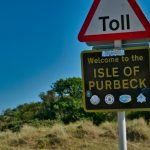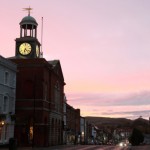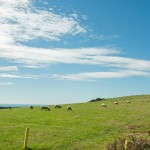
Penzance is a town and small port in Cornwall, southwest England, which is located some 64 miles (103 km) southwest of Plymouth and 255 miles (410 km) southwest of London. The name Penzance is derived from the Cornish ‘pen sans’, meaning holy headland, as a chapel once stood just west of the harbour area, albeit more than a millennium ago. Situated in the shelter of the world’s third deepest natural harbour, Mount’s Bay, the town faces south-east to the English Channel and bordered to the West by the town of Newlyn. Arguably, the town is most famous for being included in the title of the Gilbert and Sullivan, comic opera of 1879; The Pirates of Penzance. At the 2011 UK census, the town had a recorded population of 21,200.
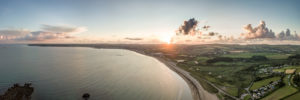
Panoramic view of Penzance’s scenic coastline
A Fleeting History of this Cornish Town
Penzance is not mentioned in the Domesday Book of 1086. It probably came into being as a small fishing village sometime during the 12th century.
During the 14th century, Penzance grew from a village into a small town. In 1332, the town’s citizens were granted their first royal charter, which allowed a weekly market and an annual fair. Medieval Penzance was a small but busy port. By 1404, the town had been granted two weekly markets and three annual fairs. In 1512, Henry VIII granted the Penzance the right to keep its harbour levies, a sign of the town’s growing importance.
In 1595, the town suffered a serious setback, when it was attacked and plundered by the Spanish, taking years to recover. However, in 1614, Penzance was granted a new charter, which saw a town mayor elected for the first time. This reflected the town’s its growing strategic importance. In 1642, the advent of the English Civil War, between king and parliament, saw the people of Penzance give resolute support to the crown. When the civil war ended in 1646, Penzance found itself on the losing side and was consequently plundered by parliamentary forces. In 1648, the town’s menfolk started an uprising but it was quickly ‘put down’ by parliamentary soldiers. In 1663, King Charles I, made Penzance a coinage (or stannary) town, where the production of refined tin was recorded for tax purposes.
18th Century Penzance
By the start of the 18th century, the small port and market town of Penzance was thriving. This was mostly on the back of the local tin industry which by this time had become the main export of the town. Other local exports included grain and smoked pilchards.
In 1739, a war began between England and Spain. In 1740, fearing a Spanish attack, the town was fortified by the building of a battery of guns along the coast. By this time, Penzance had around 600 houses, some of which were second homes of the county’s landed gentry. Penzance continued to develop throughout the late 18th century. In 1779, a grammar school was founded, the first theatre opened in 1789, the first bank in 1797. By 1801, Penzance had a population of 3,382, but over the next 50 years, it almost trembled to 9,214.
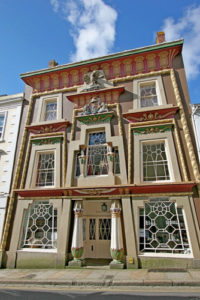
The usual Egyptian House was built in 1838
Penzance’s temperate climate was instrumental in its growing reputation as a health resort. Thus, towards the end of the Georgian period, the town continued to prosper and expand. The famed ‘Egyptian House’, Market House and the towns Guildhall, were all finished 1838 and a promenade added in 1844.
Train To London
In 1852, a railway between Penzance and Redruth was completed, which was soon extended all the way to London. This greatly encouraged tourism and made the port busier than ever. Tin was still the town’s main export. Throughout the second half of the century, the town’s port facilities were greatly expanded and a shipbuilding industry flourished. However, by the end of the 19th century, the long-standing Cornish tin industry was in steep decline, due to the overseas competition being able to produce ore far more cheaply than that locally.
By 1901, Penzance’s population had grown to 13,136. The dawning of the 20th century saw Penzance continue to develop as a tourist resort. In 1912, Penzance was one of the first towns in the country to get electric street lighting and its first cinema was opened. During the 1920s and 1930s, Penzance’s local authority began the work of clearing its slum areas, making way for the first council houses to be built in the town.
During World War II, the town suffered a total of sixteen fatalities from bombs dropped by the Luftwaffe. After the war, Penzance’s local authority embarked on an ambitious council houses building programme in the town.
The Modern Era
The economy of Penzance has, like much of the rest of Cornwall suffered from the decline of the traditional industries of fishing, mining and agriculture. It si is now dependant on light industrial, retail and tourism, the latter of which is becoming increasingly important. Still, despite this, it is still home to many and at the 2011 UK census, the town’s population was listed at 21,200.
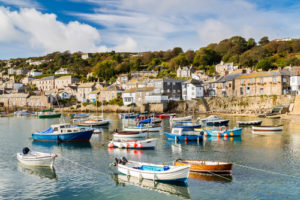
The picturesque popular fishing village of Mousehole is just 3 miles from Penzance
The much anticipated annual Golowan Festival, which dates back to pagan times, takes place in June. It offers a varied entertainment programme of open-air theatre, musical performances and a lively funfair. The event runs for a week and also includes the Mazey Day Parades. There you’ll find lots of street performers including musicians, storytellers and choirs, as well as the parade of giants, all decked out in colourful costume. Many visitors also pay a special visit for the Newlyn Fish Festival held on the late-August bank holiday weekend. In December, there’s also the Montol Festival, which comprises of six days of events celebrating Cornish traditions, as well as the midwinter solstice.
Penzance is also a major destination for art lovers since the new Newlyn Art Gallery establishment “The Exchange” opened in 2007. There’s also Penlee House which is an art gallery and museum notable for its collection of paintings by members of the Newlyn School.
Getting There
Cornwall is not the easiest of places to get to however the good news is that Penzance has relatively good rail, road, and air links with the rest of the country. here are a few tips on getting here.
By Car
Follow the M5 motorway towards Exeter until you reach the A30. Stay on the A30 all the way until you reach the town, It is fairly clearly signposted. If you’re travelling from North Devon, then you might want to take the alternative scenic route along the A39 Atlantic Highway, until you reach the A30 at Chiverton Cross.
By Bus
National Express and Megabus run coaches from almost all major locations in the UK.
By Train
There are direct train services from London Paddington, South Wales and Scotland. There’s also a sleeper service from London Paddington.
By Air
You can fly from destinations across the UK to Newquay Airport. Regular services run from London Gatwick and Manchester, with extra summer routes including Edinburgh, Birmingham, Leeds Bradford and Liverpool. From Newquay airport, it takes about an hour to get to the town by taxi or car. Alternatively, take the bus from the airport to Truro, and from there, the catch train.
Did you know?
- Sir Humphry Davy, most famed for the invention of the miner’s safety lamp i.e. the Davy Lamp, was born in Penzance in 1778
- Brought to Penzance in 1564 by Sir John Hawkins, the Dolphin Inn is reputed to be the first place in Britain where tobacco was ever smoked.
- Established in 1818, Penzance’s Morrab Library is one of the few remaining independent libraries in the UK.
- Penzance is the most westerly town in England
- The town is the setting for Gilbert and Sullivan’s Comic Opera The Pirates of Penzance
Things to see when in town
Some suggestions of things to see and do around the town:
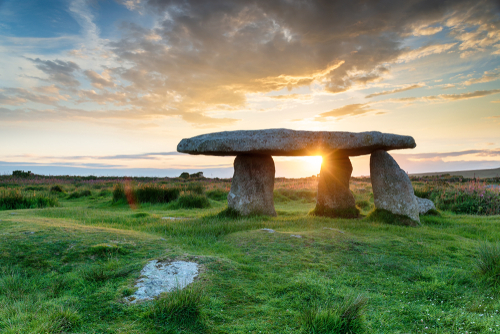
There are lots of ‘ancient stone’ sites around Penzance
- Penlee House Gallery & Museum – specialises in exhibitions of the ‘Newlyn School’ artists and local history from the stone age onwards
- Morrab Gardens – 3.5 acres of subtropical garden stretching from the centre of town to the seafront
- Ancient Stones – includes Lanyon Quoit, the holed stone of Men-an-Tol, the Merry Maidens stone circle and many more, dating back to Stone Age
- Golowan (Feast of St John) – recently revived pagan festival held around the mid-summer solstice
- The Isles of Scilly – Penzance is the only place you can sail from to the picturesque and tranquil Isles
- Jubilee Pool – an art deco lido, the largest of its kind in Britain, positioned between the promenade and the harbour
- Chapel Street – an eclectic mix of 18th-century shops, houses and hotels, including the famed Egyptian House
- The Exchange Gallery – a major contemporary art gallery & display space
Where to stay in Penzance?
If you’re looking for somewhere to stay, there’s something to suit all tastes and budgets. A broad indication of prices for the most common types of available accommodation are:
Campsites: £20 – £30 pppn
B & B/Guesthouses: £60 – £80
Standard Hotels/Inns £80 – £100
3/4/5 Star Hotels £100 – £200
Take the Penzance quiz
